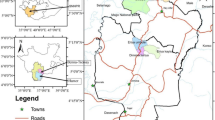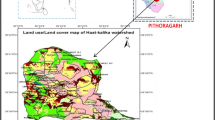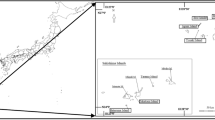Abstract
This study documents the utilization aspects and distribution of ethnobotanical knowledge of the local people of Morogoro, Tanzania, as a first step towards sustainable utilization and conservation of tropical woodlands. A total of 133 arborescent species in 31 families was identified of which 69% had a variety of uses. These uses were classified into 12 categories and major uses were charcoal, firewood, medicine, and poles. Most tree species have occasional uses, but a few are exceptionally useful and thus their levels of utilization may far exceed their regeneration and production. The questionnaire survey indicated that 62% of the respondents agreed that traditional medical services were more available than modern services. Utilization surveys indicated that wooden poles are the building material used in 98% of the dwellings and storage structures, wild foods were useful for food security especially during drought years, and high quality timber trees have been depleted in the forest because of earlier exploitation by pit-sawing. The distribution of ethnobotanical knowledge indicated that much of the relevant ethnobotanical and utilization information was held by more aged members of the society and hence there is a clear need to capture this knowledge before it is lost. This study has shown that resources are defined by use and culture, and some components of ethnobotanical knowledge have potential for the sustainable management of miombo woodlands.
Résumé
L’étude porte sur les différentes utilisations, distributions ainsi que la connaissance ethnobotanique de l’ethnie locale du Morogoro en Tanzanie, comme première étape vers une meilleure utilisation et conservation des régions forestières tropicales. Un total de 133 espèces arborescentes ont été identifiée, 69% des 31 familles font l’objet de diverses utilisations. Ces utilisations sont classées en 12 catégories. Les principales utilisations sont le charbon, le bois de chauffe, la médecine. La majorité des espèces d’arbre sont utilisées occasionellement mais certaine sont très utiles et ainsi leur niveau d’utilisation dépasse de loin de taux de production et de régénération. Le questionnaire indique que 62% des personnes interrogées préfèrent la médecine traditionnelle plus accessible que celle moderne. Le bois est surtout utilisé comme matériaux de construction dont 98% pour maison et le stockage. La nourriture sauvage a été très utile pour l’hygiène alimentaire, spécialement durant les années de sécheresse et de forte exploitation forestière. La distribution de la connaissance ethnobotanique indique que la majorité des informations sont tenues par les personnes agées de la société et il est impératif de conserver cette connaissance avant qu’elle ne soit définitivement perdue. Cette étude a montré que les ressources sont définies par l’utilisation et la culture. Certaines parties de la connaissance ethnobotanique sont alors nécessaire pour une bonne exploitation des régions boisées du miombo.
Similar content being viewed by others
Literature Cited
Anderson, A. B., and D. A. Posey. 1989. Management of a tropical scrub savanna by the Gorotire Kayapo of Brazil. Advances in Economic Botany 7:159–173.
Campbell, B. M., M. Luckert, and I. Scoones. 1997. Local level valuation of savanna resources. A case study from Zimbabwe. Economic Botany 51:59–77.
—,and R. F. du-Toit. 1988. Relationship between wood resources and use of species in the communal lands of Zimbabwe. Monographs in Systematic Botany of the Missouri Botanic Gardens 25:331–341.
—,J. Clarke, M. Luckert, F. Matose, C. Musvoto, and I. Scoones. 1995. Local-level economic valuation of savanna woodland resources: village cases from Zimbabwe. Hidden Harvest Project Research Series 3. International Institute for Environment and Development, London.
Caniago, I., and S. F. Siebert 1998. Medicinal plant ecology, knowledge and conservation in Kalimantan, Indonesia. Economic Botany 52:229–250.
Clarke J., W. Cavendish, and C. Coote. 1996. Rural households and miombo woodlands: Use value and management. Pages 101–135in B. Campbell, ed., The miombo in transition: woodlands and welfare in Africa. Centre for International Forestry Research (CIFOR), Bogor, Indonesia.
Cunningham, A. B. 1993. Low cost housing needs, wood use and woodlands. Pages 283–291in G. D. Pierce and D. J. Gombo, eds., The ecology and management of indigenous forests in southern Africa. Proceedings of an International Symposium, Victoria Falls, Zimbabwe, 27th-29th July 1992. ZFC & SAREC, Zimbabwe.
FAO. 1990. The community tool box. The idea, methods and tools for participatory assessment, monitoring and evaluation in community forestry. Community Forestry Field Manual 2. Thailand.
Fleuret, P. C., and A. Fleuret. 1978. Fuelwood use in a peasant community. A Tanzanian case study. The Journal of Developing Areas 12:315–322.
Gauslaa, Y. 1989. Management and regeneration of tropical woodlands with special reference to Tanzanian conditions. A literature review. LIDIA 2: 73–112.
Grundy, I. M., B. M. Campbell, S. Balebereho.,R. Cunliffe.,C. Tafangenyasha.,R. Fergusson, and D. Parry. 1993. Availability and use of trees in Mutanda resettlement area, Zimbabwe. Forest Ecology and Management 56:243–266.
Hall, J. B., and W. A. Rodgers. 1986. Pole cutting pressure in Tanzanian forests. Forest Ecology and Management 14:133–140.
Kielland-Lund, J. 1990. Phytosociology and productivity of four forest and woodland communities near Morogoroin A. S. M. Mgeni, W. S Abel, S. A. O. Chamshama and G. S. Kowero, eds., Proceedings of a Joint Seminar/Workshop on “Management of Natural Resources of Tanzania” Under SUA/AUN Cooperation, 5th-10th December 1990, Arusha, Tanzania. Faculty of Forestry Record, Sokoine University of Agriculture, Morogoro, Tanzania. 43:2–15.
Lewis, W., and M. Elvin Lewis. 1990. Obstetrical use of parasitic fungus Balansia cyperi by Amazonian Jivaro women. Economic Botany 44:131–133.
Liengme, C. L. 1983. A study of wood use for fuel and building in an area of Gazankulu. Bothalia 14:245–257.
Luoga, E. J. 1995. Indigenous knowledge and sustainable management of forest resources in Tanzania. Pages 139–151in R. E. Malimbwi and E. J. Luoga, eds., Information acquisition for sustainable natural forest resources of eastern, central and southern Africa. International workshop proceedings, Arusha, Tanzania, 4th-9th November 1994. Sokoine University of Agriculture, Morogoro, Tanzania.
Mandondo, A. In press. Cultural belief and their potential implications for land-use and land-cover changes in eastern Zimbabwe. Journal of Agriculture and Human Values.
Martin, G. J. 1995. Ethnobotany: A people and plants conservation manual. Chapman & Hall, London, UK.
Mazambani, D. 1993. Aspects of the use of indigenous wood biomass resources in Zimbabwe’s communal lands: Case studies from Chivi and Zvishavane districts. Pages 292–300in G. D. Pierce and D. J. Gombo, eds., The ecology and management of indigenous forests in southern Africa. Proceedings of an International Symposium, Victoria Falls, Zimbabwe, 27th-29th July 1992. ZFC & SAREC, Zimbabwe.
Mbwambo, L., B. Koppers, and B. Lenge. 1995. Miombo tree species’ utilization and preference survey in selected villages of Tabora, central Tanzania. A joint report prepared by the Miombo Woodland Research Centre / Forest Resources Management Project (FRMP). Tabora, Tanzania.
Medley, K. E. 1993. Extractive forest resources of the Tana River National Primate Reserve, Kenya. Economic Botany 47:171–183.
Mukamuri, B. B. 1997. Use, patterns and marketing of medicinal plants and animals in Zimbabwe’s urban and rural areas. A report prepared by the Institute of Environmental studies for Traffic-East/Southern Africa, IES, University of Zimbabwe, Harare, Zimbabwe.
Mushove, P. T. 1993. Fifty-five years of timber commercialization in Tsholotsho communal land. Pages 320–325in G. D. Pierce and D. J. Gombo, eds., The ecology and management of indigenous forests in southern Africa. Proceedings of an International Symposium, Victoria Falls, Zimbabwe, 27th-29th July 1992. ZFC & SAREC, Zimbabwe.
Nduwamungu, J. 1996. Tree and shrub diversity in miombo woodlands. A case study at SUA Kitulanghalo Forest Reserve, Morogoro, Tanzania. M.Sc. dissertation, Faculty of Forestry, Sokoine University of Agriculture, Morogoro, Tanzania.
Phillips, O. and A. H. Gentry. 1993a. The useful plants of Tambopata, Peru: 1. Statistical hypothesis tests with a new quantitative technique. Economic Botany. 47:15–32.
— 1993b. The useful plants of Tambopata, Peru: 1. Additional hypothesis testing in quantitative ethnobotany. Economic Botany. 47: 33–43.
Prance, G. S., W. Bailee, B. M. Boom, and R. J. Carnaria. 1987. Quantitative ethnobotany and the case for conservation in Amazonia. Conservation Biology 1:296–310.
Smith, W., T. C. Meredith, and T. Johns. 1996. Use and conservation of woody vegetation by the Batemi of Ngorongoro district, Tanzania. Economic Botany 50:290–299.
URT. 1991. Population census national profile. Bureau of Statistics, President’s Office Planning Commission, Dar es Salaam.
Wehmeyer, A. S., R. B. Lee, and M. Whitting. 1969. The nutrient composition and dietary importance of some vegetable foods eaten by the Kung Bushmen. South Africa Medical Journal 43:1529–1532.
Author information
Authors and Affiliations
Rights and permissions
About this article
Cite this article
Luoga, E.J., Witkowski, E.T.F. & Balkwill, K. Differential utilization and ethnobotany of trees in kitulanghalo forest reserve and surrounding communal lands, eastern tanzania. Econ Bot 54, 328–343 (2000). https://doi.org/10.1007/BF02864785
Received:
Accepted:
Issue Date:
DOI: https://doi.org/10.1007/BF02864785




